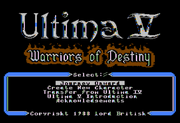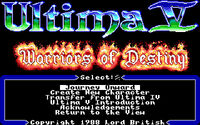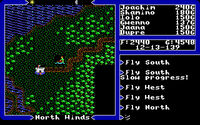Ultima V was the last game of the series to be originally developed on the Apple II. Like Ultima IV, the growing technology of computers created several ports that technically looked and sounded quite different, despite having the same game content. Note that this does not cover the NES-Port of Ultima V, which is a separate article because of serious changes done to the game content-wise.
Apple II Series[]

Apple II Title Screen

Apple II in-game
Ultima V was initially written to run on all 8-bit Apple II series (II+, IIc, IIc+, IIe) computers; the 16-bit Apple IIgs ran it using a transparent built-in IIe emulation mode. The game came on four double-sided 5.25" floppy disks: Program & Dungeons, Britannia & Underworld, Townes & Dwellings, Castles & Keeps. The Britannia disk was used for the savegame; the bootup Program disk was the only one that couldn't be read and copied with appropriate software.
The game made full use of the APL2's 280×196 high-resolution mode, which had six colors: orange, blue, magenta, green, black and white. As with other Apple II software, Ultima V made use of blue & orange being offset from the other colors by a half-pixel to smooth the edges of images & fonts. This was augmented by the slightly fuzzy images produced by the NTSC-based signals and composite monitors, an effect not seen on most AppleⅡemulators or screenshots.
As with other platforms, a wide range of sound effects was included, along with a number of short situational melodies were available as well. A full musical score was available for an Apple IIe with 128k of RAM or Apple IIgs equipped with one of several popular MIDI boards, such as Sweet Micro Systems' Mockingboard, Applied Engineering's Phasor, or Passport Designs' MIDI interface. Since some were the same MIDI instruments used by professional musicians, the end-results varied but could be quite impressive with the right setup. Examples of the soundtrack played with different hardware: Phasor and dual Mockingboards.
The C64/128 Port[]

C64 Title Screen

C64 Intro

C64 in-game
The port for the C64/C128 was created by Dr. Cat.
First off, compared to the Apple II, the graphics are clearly improved. They are now much more colorful and the color also is at the right spots (such as red paved roads). For a resolution of 320x200, they managed to get out the maximum. The low resolution however means, that indoor peer maps are never completely on the screen. Also, while the dungeon graphics are even better than the Apple II ones, they are still only one color. Also, this color is mostly off, since the cave dungeons are all blue, while brown would have been more fitting. The introduction remains in bad graphics.
While the port features a full musical score, the C64 simply does not have enough available RAM to play it. To access the music, the game must be played on a C128 computer running in C128 mode.
There also were technical problems with the fastloader. Thanks to sloppy programming, it only works on a NTSC C64, not a PAL one, which greatly annoyed players in Europe. On a C128 with a 1571 drive, the native fastloader is used and so there were no problems..
One last thing of interest: the C64 port was released on 4 double-sided 5.25" floppy disks. Thankfully Origin had been wise enough to partition them into logical chunks to keep disk-swapping at a minimum. The sides are:
- Game (loading, menu and saved games)
- Dungeon (everything in the dungeons)
- Britannia (the overworld)
- Underworld (as the name says)
- Towne (cities and villages)
- Dwelling (huts. Also contains the intro and endgame)
- Castle (big castles like Castle Britannia)
- Keep (small fortresses like Bordermarch)
The Intro in the C128-mode with music
The Atari 8bit Computer Port[]

Atari 8bit U5 Title Screen

Atari 8bit U5 Credits
The Atari 8bit port of Ultima V was started. Disk 1 and 2 have been found, however the 'Britannia' disk has not. Richard Elliott on a 'Genie' chat at the time promised the Atari community that the 8bit port had been contracted out and would be finished. A screenshot of the title and credits screen is the only working part that has been found at this time. Not sure if anyone knows Rob Santonica who is credited with the 'Translation' to fill in the missing pieces.
The 16-Bit Ports[]

16-Bit Title Screen

16-bit in-game

The "Ultima V"-logo on Atari and Amiga
The ports for the 16-bit machines done for the Amiga, Atari ST and the IBM-PC are far more advanced than the previous two. Graphically they all look exactly the same; 16 color graphics in a 320x200 resolution. The Amiga and Atari always have an "Ultima V" logo on the screen.
The Amiga and Atari ST ports have mouse support, something that the PC port doesn't have (a mouse still was only optional for a PC in 1988).
The Amiga version is rather buggy, especially with the way the keyboard is read. Too often, keypresses will either not be read at all, or will "stutter" and (for example) a single keystroke will be interpreted as three. These bugs have never been patched. Furthermore there was no option to transfer the character from Ultima IV and it was not possible to copy one of the disks to have multiple characters at the same time. If one wanted to create a new character the old one was overwritten by the new one. Some users also report crashes during the game which would cause the disk to be overwritten and unusable.
The biggest difference is how music is handled. The Atari ST port has full music. However, the pieces are played in places that do not correspond with the C128 or Apple II version. For example, "Villager Tarantella" is played in all eight Cities of Virtue in the C128/Apple II versions, but the Atari ST version instead plays "Greyson's Tale" in all but New Magincia.
On the Amiga, only one song (unique to this version of the game) is playing the entire time, despite the Amiga clearly being able to shoulder all of the music. It is unknown why this decision was made.
The IBM-PC port originally had no music at all, since Adlib soundcards only came on the market a little after Ultima V's release. The Ultima V Upgrade Patch re-inserts all the music from other versions.
The IBM-PC port consists of four 5.25" floppies, and it is supposed to be installed on the hard disk. The Atari port has three 3.5" floppies and the Amiga two 3.5". The Amiga version cannot be installed to a hard drive and the computer must be booted from the floppies in order to play the game.
The Japanese Ports[]

FM-Towns Introduction

Sharp x68000 Title Screen
The Sharp x68000 version of Ultima V contains completely redrawn tile graphics that take advantage of the Sharp X68000's superior graphic abilities. This version also includes the complete music track available in other versions. This version is only available in Japanese.
The FM-Towns version of Ultima V plays identical to other versions of Ultima V, but takes advantage of the CD-ROM capabilities of the FM-Towns machine to include high-colour graphics in the introduction. The tile graphics appears to be based on the other 16-Bits versions but seems to have a smaller color palette which makes them look slightly inferior. A CD-quality music track accompanies the FM-Towns version of Ultima V, although the music is used in a way that is different from both the Apple II/C128 version and the Atari ST version : for instance "Greyson's Tale" will play into the cities of Virtue like in the Atari ST version, but "Stones" will play while camping just like in the Apple II/C128 version.
| Computer Ports | |
|---|---|
| Games | Ultima I ☥ Ultima II ☥ Ultima III ☥ Ultima IV ☥ Ultima V ☥ Ultima VI |